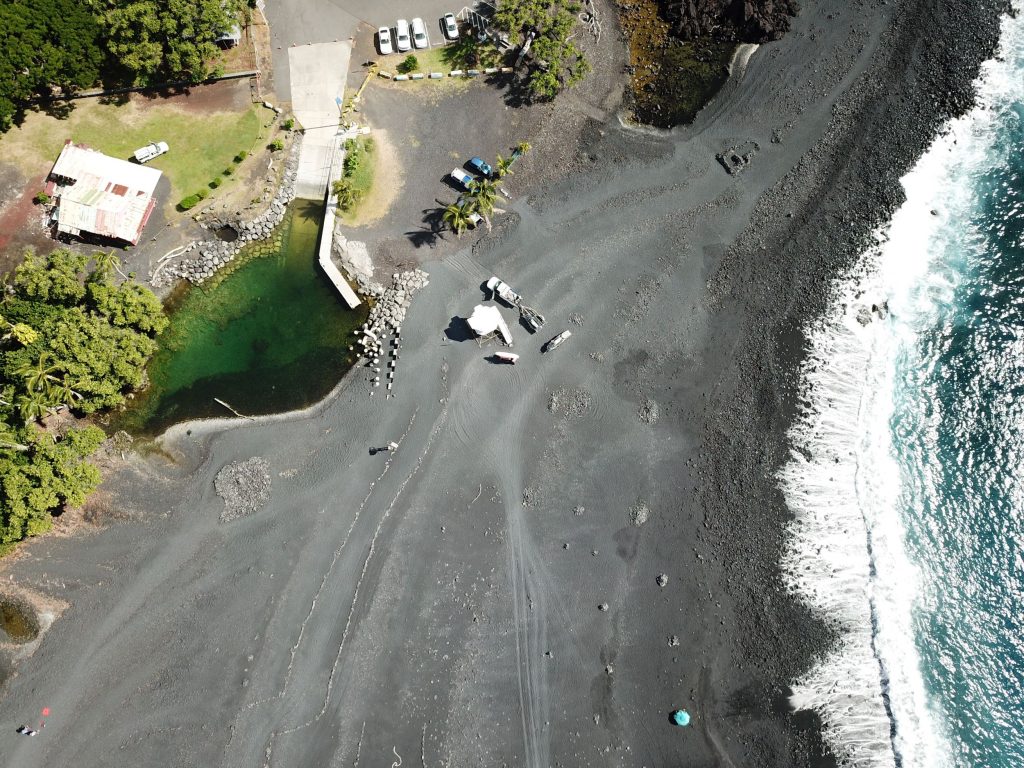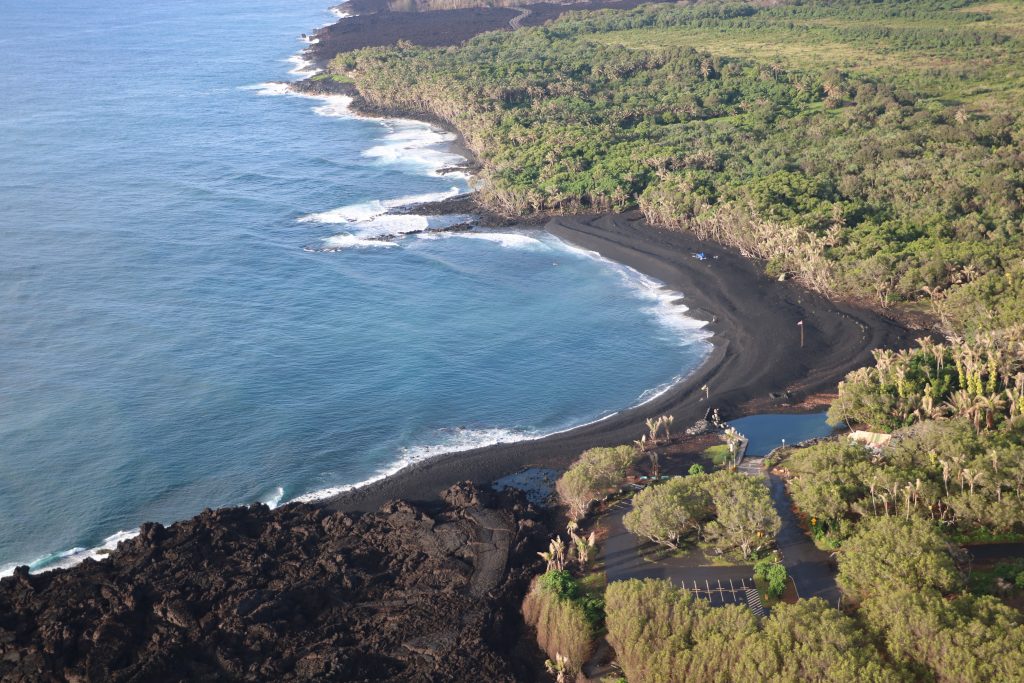Big Island’s Pohoiki boat ramp — landlocked by 2018 Kīlauea eruption — could reopen by end of 2024
The long, frustrating wait to regain direct access to the ocean and lucrative fishing grounds via Puna’s Pohoiki boat ramp — which became landlocked during the 2018 Kīlauea eruption — could finally be over before the end of next year.

Finn McCall, head of the engineering branch for the Hawai‘i State Division of Boating and Ocean Recreation, said if everything goes smoothly with permitting and any other red tape, a dredging project to reopen the ramp could begin as early as February or March of 2024.
With it estimated to take 6 to 9 months to complete, the state-owned ramp would be ready to use around December 2024.
This dredging project is a scaled down version of a proposal that the state wanted — and was the preferred choice of the community — to return the bay as close to pre-eruption conditions as possible. It called for dredging and removing most of the about 11 acres — or about 175,000 cubic yards — of accumulated volcanic debris that created a new black sand beach and blocked ocean access.
But it would cost an estimated $40 million. Hawaiʻi state legislators were not prepared to fully fund it during the 2023 session because they did not have a commitment from the Federal Emergency Management Agency to provide disaster assistance reimbursement for the project.
Instead, Puna state Rep. Greggor Illagan and state Sen. Joy San Buenaventura were able to get the state to fund $5.4 million for a “more modest dredging option.”
This version of the project will dredge and remove about 42,000 cubic yards of debris and create a 15-foot-wide channel from the end of the currently landlocked boat ramp that would increase to a width of 160 feet where it meets the ocean, with depths from 6 feet at the ramp’s end to 12 feet at its mouth.
McCall said the new channel will be able to accommodate any boat that was able to use the ramp prior to the eruption. The widths and depths also could change based on the project’s final design, which is still being ironed out by the Division of Boating and Ocean Recreation.
A portion of the new black sand beach will remain on the south side of the channel. Some of the removed material will be used to fill in a hot pond behind the beach created when the volcanic debris trapped water there, which was requested by the owners of private property the pond straddles.
The downside of the smaller project is that it will require regular maintenance dredging to keep it clear of debris.
McCall isn’t yet sure how often that will be necessary. Officials don’t anticipate materials getting back into the channel immediately and the state will continually monitor the situation.
McCall added that most of the volcanic debris in the bay has stabilized and accumulation has ceased. In the past three years, it’s also started to erode. That could actually make future dredging easier.
For the project, some agencies have pledged to expedite review of applications. It already has been too long of a wait for many people who rely on the ramp.
Five years ago, lava from the unprecedented 2018 lower East Rift Zone eruption of Kīlauea volcano came within about 230 feet of the boat ramp. The flow pushed sand, rocks, cobbles and other volcanic debris into Pohoiki Bay, creating a new black sand beach but severing the ramp’s access to the Pacific Ocean.

It cut off some of Hawai‘i’s best fishing grounds from lawai‘a (fishermen), whose families for generations have called the Pohoiki area home and fished out of the bay for their livelihoods.
The boat ramp is the only one between Hilo (40 road miles to the north) and Punalu‘u (81 miles to the south). Losing its use has caused hardship for the community’s fisherman, who are forced to spend more money and time to travel elsewhere just to get their boats in the water only to face longer and more dangerous trips to get to the fishing grounds outside Pohoiki Bay.
Many lawai‘a have called it quits, selling their boats and taking in their lines for good.
“It’s crazy. It’s ridiculous. It’s unacceptable,” said Aunty Ku‘ulei Cooper-Springer, who’s family of farmers and fishermen has called Pohoiki home for seven generations, about how long the boat ramp situation has languished and the resulting consequences. “We are thankful it’s going to change.”
After years of community pleas that have gotten louder this year to reopen the ramp, the 66-year-old said state officials have assured the community that they are working together with Hawai‘i County and other involved agencies to meet any challenges that could arise and the planned complete the dredging project. Albeit at a smaller level than what was hoped.
The state spent several years after the eruption looking at alternatives, including other sites for a new boat ramp, but Puna’s high sea cliffs, rough ocean conditions and cultural and historical considerations in other areas made another location unfeasible. The COVID-19 pandemic also stalled progress on a potential project.
When officials discovered the accumulation of debris in Pohoiki Bay had stabilized and trade wind currents were eroding the north side, where the existing ramp channel is located, they determined because of the natural protection it offers that Pohoiki is still the best place for ocean access and moved forward with plans there.


During the new dredging project, a trail also will be installed to get to the beach area and the last remaining natural warm spring at Pohoiki, which was spared by the eruption. The pond at the end of the boat ramp that was created by the eruption will become part of the new channel to the ocean.
A sediment transport study for the boat ramp area with the U.S. Army Corps of Engineers also is in the works.
While McCall and community members are disappointed that the proposed $40 million project isn’t the one moving forward, they understand why. There is always the possibility state lawmakers could provide additional funding in the future, but the main objective since Day One has been to provide ocean access to the Pohoiki community.
“They are extremely excited,” McCall said. “It’s not so much excited as they are relieved. They’ve been just struggling so bad since they’ve been cut off from the Pohoiki boat ramp. They’re just glad that we have funds to do something that will reopen the boat ramp for them, and that’s really the main thing that they’ve been asking for.”
According to written testimony from geologist and Puna resident Philip Ong in support of House Bill 701, which was proposed this year by Illagan to fund the proposed dredging project, state Land Department data shows Pohoiki was the third most productive fishing area in the state through 2017. Fishermen brought in an annual average of $1.3 million in catch from 1997 to 2001, equivalent to $2.2 million per year in 2022 after adjusting for inflation.
“An average of almost 400,000 pounds of fish were landed there every year, a significant contribution to local food sustainability, but by 2019 the catch was reduced to one-third of that amount,” Ong wrote. “Fishermen continue to endure hardship after 4 years, forced to launch from Hilo for longer, costlier trips that also burden their families with less time at home. The need is urgently real, with the prolonged closure already threatening the Puna fishing industry.”
The landlocked boat ramp also has impacted other stakeholders, including other commercial and recreational activities and even emergency rescue services, including the U.S. Coast Guard, that have also relied on the ocean access at Pohoiki for decades.
The ocean is central to the way of life for the Puna community, it’s the culture. Cooper-Springer said fishing is as important to Hawaiians as kalo.
“Our land and our access to the ocean is valuable,” Cooper-Springer said, adding that before the eruption cut Pohoiki off from the Pacific, “every weekend, there were families galore, fishermen, surfers, all of it.”
It is a wahi pana, a sacred place, that is special for fishing and also as a close-knit family gathering area. Pohoiki holds an indescribable mana, or power, and was a place where families would congregate, whether it was to exchange fruits, vegetables and their local catch or to simply enjoy each other’s company.
Cooper-Springer said she and other community members are already working with Hawai‘i County officials to make sure Isaac Hale Beach Park, adjacent to the boat ramp, is a family-oriented place after the ramp reopens, with stewardship programs in place to educate visitors and residents alike about what Pohoiki means to the community’s culture.
She hopes with the restoration of ocean access at Pohoiki, the community can return to those roots: “I believe that’s possible.”












